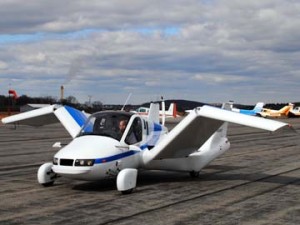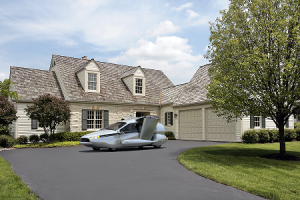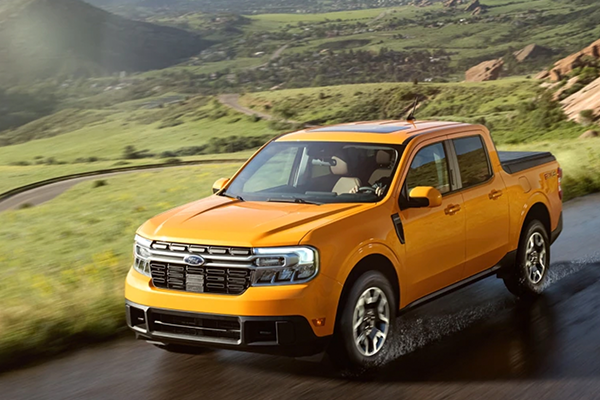 Photo credit: Terrafugia
Photo credit: Terrafugia
Okay . . . you’re driving down the smog-choked road. Not really driving, more like idling since the traffic is dreadful. You could leave the highway at the next exit–if you ever get there, that is–or you could sing along with your radio for an hour or two to help pass time. Or, if you’ve purchased one of the world’s amazing new flying cars, you could someday simply extend your wings and glide the rest of the way home.
Sounds like sci-fi, doesn’t it? Well, a company named Terrafugia recently announced the upcoming release of not one, but two, cars that can transition from ordinary road/land driving to flying: the Transition and the TF-X. The first of the two should be ready for use in–ready for this?–2015.
Terrafugia’s CEO, Carl Dietrich, believes that flying cars will benefit people in hugely significant ways, saying that the possibilities are impossible to even quantify.
The Transition
The Terrafugia website describes the Transition as a “street-legal airplane that converts between flying and driving modes in under a minute, “which brings a “new level of freedom, flexibility, and fun to personal aviation.” At this point, the Transition must be driven to an airport for takeoffs and landings; drivers will need to have a valid standard driver’s license as well as sport pilot certification.
Advantages listed include:
- The flying vehicle can land and drive in bad weather
- Fits into a standard single car garage; no trailer or hangar required
- Can fly in and out of more than 5,000 public U.S. airports
- Legal to drive on public roads and highways
- Meets Federal Motor Vehicle Safety Standards
- Equipped with a parachute, driver/passenger airbags and automotive crash safety features
- Uses the same engine for driving and flying
- Can use premium gasoline rather than the more expensive aviation fuel
- Cargo area available
This can be yours for only $279,000, with a $10,000 deposit due upon reservation of the vehicle. Approximately 100 people have reserved this land/air vehicle to date. Check out this video of the Transition both driving and flying. And, this one. Photo credit: Terrafugia
Photo credit: Terrafugia
Other cars racing to be the first to command the skies include PAL-V ONE by PAL-V Europe NV and the Aeromobil by a Slovakian company led by Stefan Klein.
History of flying cars
Perhaps the Transition will become the first truly successful flying car. This definitely isn’t the first serious attempt, however. In fact, the idea of flying cars is pretty old, nearly as old as the automobile itself.
Here are some highlights:
- Henry Ford began assembling his first auto prototype in 1892
- Just 11 years later, on August 17, 1903, Dr. Trajan Vuia of Paris, France filed a patent for a flying car
- On December 17, 1903, the Wright brothers test flew their aircraft
- In 1912, a car carried by a hot air balloon was imagined
- In 1919, the Autoplane by Glenn Curtiss took a short test flight
According to Doug Hilton, the Englishman who crossed the English Channel in an Amphicar–and who is working to set up a Land, Air and Sea Museum to honor dual-purpose vehicles–more than one hundred patents already exist for flying cars. Few have reached the mock up stage, Doug says; not surprisingly, most of them have been worked on in the United States.
And, even when designers and engineers weren’t necessarily thinking about a working prototype of a flying car, they were often inspired by airplanes in their creations. For example, here is a video of film shot in 1948 that shows car prototypes that didn’t actually fly but were “streamlined as a plane” and contained multiple airplane principles and features; these prototypes include the Davis 3-wheeler. The narrator of the video often uses airplane-like lingo, including “fuselage” and “cockpit,” saying that these vehicles “only need a pair of wings to be comfortable in the sky” and were “wasting time on the ground.”
Prototypes of interest that actually flew include (but are not limited to!) the:
- Waldo Waterman Aerobile in 1937: three-wheeled car with detachable wings and a Studebaker car engine
- Robert Fulton Airphibian in 1947: four airplane-sized wheels with a six cylinder Franklin aircraft engine
- Moulton B. “Molt” Taylor AEROCAR in 1956: Lycoming airplane engine with front-wheel drive; flight module included the wing, rear fuselage, draft shaft and propeller
Each of the three vehicles listed above earned certification as an aircraft but only a handful of vehicles were actually produced in each instance. Molt Taylor’s, though, nearly reached mass production.
Molt Taylor and the AEROCAR
Paraphrase of Molt’s philosophy: Airplanes never take you where you want to go. They take you to airports.
Now, who can argue with that??
Molt was born in 1912, not long after the first successful flight tests by the Wrights. When he was just 14, he got a ride in an old biplane and quickly learned to fly himself. When he became of age, he got a pilot’s license and earned degrees in aeronautical engineering and business, and also became a naval aviation cadet.
He didn’t stop there, either. He built his own plane from the remains of another and invented an inexpensive aircraft radio, forming the Taylor Airphone Products company to sell his invention. When World War II broke out, he served the U.S. as Lt. Commander in the navy, helping to invent the surface-to-surface missile, a powerful weapon with a television camera in its nose. Molt became the first person to test that someone could both fly an airplane and discharge this missile; this act of bravery earned him the Legion of Merit.
After the war ended, Molt fully deserved to return to his company and rest on his laurels. Instead, he persuaded fifty people to invest $1,000 each (equal to an investment of $9,803.92 in today’s dollars) and, in nine short months, created a workable prototype of a flying car: the AEROCAR 1.
After performing this astonishing feat of engineering, it took him a few years to raise the $750,000 ($7.4 million in today’s dollars) needed to get this vehicle certified. This was accomplished in 1956 and six vehicles were produced.
The cost to build was $25,000 each but Molt planned to find ways to get the retail price down to $15,000. A television star, Robert Cummings of Love That Bob, bought one and would land at airports to crowds of cheering fans.
Molt struggled to get the AEROCAR into production, but nearly achieved that goal in 1970, when Ford Motor Company expressed interest and committed to building 25,000 per year. Unfortunately, the Department of Transportation requirements created a financial roadblock that could not be overcome.
Of the original six AEROCARs built, five of them still existed in 1990 (and may still exist today!). The other was destroyed during testing. Plans existed for an AEROCAR 2000 but this has not yet come to fruition.
What’s Next? The TF-X The TF-X takes flight. Photo credit: Terrafugia
The TF-X takes flight. Photo credit: Terrafugia
Terrafugia, the company that plans to bring the Transition to market in 2015, is also working to create a “four-seat, plug-in hybrid electric flying car . . . TF-X ™ will provide true door-to-door transportation combined with the freedom of vertical takeoff and landing – creating a new dimension of personal mobility.” In other words, you won’t need to drive to an airport for takeoff and landing. How cool would that be?
The TF-X is projected to include multiple safety features that should make driving one safer than a typical automobile–by automatically avoiding other traffic. Emergency features include a backup parachute system and auto-land if the pilot is unresponsive. Flight training for safety purposes should take a typical driver up to five hours, but other licensing requirements are likely.
Pricing has not yet been determined, although it may be comparable to “very high-end luxury cars.” The vehicle is expected to be in development for 8 to 12 more years before being released to the public.
Expert commentary
Doug Hilton, founder of the emerging Land, Air and Sea Museum in England, has this to say about the development of flying cars:
Perhaps the biggest astonishment is that it’s taken sixty years for a worthy successor to come along since Molt Taylor offered the first ever fully certified flying car to the public in the early 1950s. Molt Taylor’s Aerocar had only six variants made and some of these are amazingly still flying."
The Terrafugia company, however, is hoping to sell many more than this of their Transition and when we see such creative and skilled engineering driven by such passion and dedication, we can only wish them the best of success."
But why has it taken so long?
Well there are many reasons behind that lag, including the fact that at over a quarter of a million dollars each, these are likely to be a niche product. This is a lot of money to pay for any car or light plane.
Apart from fear of development costs and over potential sales, the main reason for the time lag with no public offerings is the huge amount of testing and certification required. It was almost unbearably tough when Molt Taylor produced his Aerocar in the 1950s but since then the sky seems to have poured more regulations every year than rain and the world has entered a phase whereby if someone gets it wrong, or takes a risk that fails to come off, then rather than accepting it, people instantly try to find someone to sue. This completely shut down light aircraft production in the mid-1980s, so it’s a brave manufacturer that is prepared to enter anything quite as interesting in the product field as a flying car and the world has been a poorer place for it.
The Terrafugia team have battled hard to meet current laws relating to both civil aviation aircraft construction regulations and those of road use; probably harder than anyone that has never been involved with this kind of thing can imagine as the concept of flying cars is alien to bureaucrats.
Even then, several exemptions have had to be obtained for this two person flying car including a permitted weight increase that still keeps it in the ‘Light Sport’ category under which the benefits of considerably reduced license conditions apply – and this factor will appeal to many.
This however comes with restrictions on weight and top speed, so it’s unlikely that you would purchase one of these for major cross country flying but the quoted figures of 100 mph cruise speed and 410-mile range with 30 minutes reserve are no slouches and could be ideal in the right weather for general flights to the office and back and make it a serious contender against more energy hungry, heavier planes.
Terrafugia would of course say that if the weather turns bad you simply land and go by road but this assumes a safe road to land on and the right wind direction. Pilots with skills more advanced than perhaps the average Light Sport pilot may possess could be required before just dropping into a strange highway. Any distance on the roads might also become a bit wearing on both the lightweight vehicle and the driver but time will tell.
In designing a flying car a decision normally has to be made as to if it’s going to be a car that occasionally flies in order to avoid those dreaded traffic jams, or a plane that occasionally lands and drives when the weather turns bad.
In this case the design is no secret. The Terrafugia Transition has been designed as a plane that drives a typical driving range of up to 20 miles from the landing point. This seems a spot-on design choice and will make many of those small landing strips ideal for use without having to bother with a big runway and the fees that go with it and then the car hire.
The exciting use of ultra-modern lightweight materials and engineering design flair has made possible details such as those amazing self-retracting wings and helped to reduce weight while permitting rigidity of construction.
This is a major and long overdue step to a real future for flying car design. Coming next? Well the Terrafugia TF-X could well take the flying car market well into personal helicopter car design. At home with the TF-X. Photo credit: Terrafugia
At home with the TF-X. Photo credit: Terrafugia
What Else is Next? Civilian Space Travel
The reality is that a non-astronaut has already been in space, the wealthy scientist and entrepreneur Dennis Tito from the United States who paid Russians for a ride to the International Space Station in 2001. Soon, it’s likely that Sir Richard Branson (head of Virgin Galactic) and his wife will make a suborbital trip. After that, the couple plans to offer trips to other paying customers.
A trip will, according to the website, “allow an out-of-the-seat, zero-gravity experience with astounding views of the planet from the black sky of space for tourist astronauts and a unique microgravity platform for researchers.”
Virgin Galactic President and CEO George Whitesides shares his own vision of space travel in the future. “Over the next 30 years,” Whitesides says, “I believe thousands, and perhaps even millions, of private individuals will travel to space. As we progress through the 21st century, space flight may become nearly as common for travelers as taking a plane trip became for millions across the world during the 20th. The technology that permits flights into space will also allow passengers to fly to far-flung places on Earth in record time. By traveling out of the Earth's atmosphere for a small amount of time, a non-stop trip from New York to Sydney might take two to three hours instead of the 20-hour, multi-leg trip required today.
“Furthermore, I believe air travel will be more environmentally friendly. Airlines ferrying passengers on regional routes will run small, short-hop planes on battery cells. Now is a fascinating time for the commercial space industry. It is inspiring to see business leaders from different sectors applying their best ideas and practices to the unique challenges of space flight. The next 30 years hold exciting, unexplored territory for the people of the world.”
To date, Virgin Galactic has received more than $70 million in deposits and have approximately 640 customers waiting at the edge of their seats for their suborbital flights on SpaceShipTwo, VSS Enterprise. SpaceShipTwo has already undergone two successful test flights–in April 2013 and September 2013.
“The path is now clear,” a Virgin Galactic company spokesperson says, “to a fairly small number of similar flights, which will see a rapid expansion of rocket burn time, culminating in a full space flight, which we expect to achieve during 2013. We will need to undertake a number of test space flights, and fit and flight test the interior. Our best estimate at the moment, if test flights continue as expected, is that we could see the first paying customer flights in 2014.”
Flight options currently offered by Virgin Galactic include paying the full $200,000 per seat price to become one of the first 1,000 humans to experience space travel; to pay a deposit of $20,000 to guarantee the price of $200,000 for a flight to be scheduled after paid-in-full customers travel in space; or to pay $1 million to charter an exclusive trip for yourself and five of your closest friends. (The website notes that, with the $1 million payment, a space tourist would in fact get six tickets for the price of five!) Photo credit: Mark Greenberg
Photo credit: Mark Greenberg
When asked about what types of people are signing up for the early space flights, the Virgin Galactic company spokesperson believes that they are all “passionate about this project and can't wait to experience space for themselves. They also recognize the importance of early adopters in the successful evolution of any new industry and know they are booking a place in history. In the lead up to the flight they are a part of a unique, global, actively engaged community–in some ways the most exclusive club on Earth.”
Life in Space
As farfetched as it once seemed, a company called Bigelow Aerospace is already designing cabins that will be launched into space in 2015. Once they arrive at the International Space Station, these cabins will expand into 13 x 10 foot living spaces where astronauts can give them a try as far as practicality goes.
On January 5, 2018, a man and woman should fly past Mars in an initiative from a foundation called, appropriately enough, Inspiration Mars. Because of the planetary alignment on that date, this trip is expected to take only 501 days and will further open up possibilities for space travel.
For more information, check out this handy infographic on flying cars (double-click to grab a copy):
Editor's note: What do you think? Do you plan to put down a deposit on a flying car? Hitch a suborbital ride with Virgin Galactic? Visit Mars? Let us know in the comments below!








